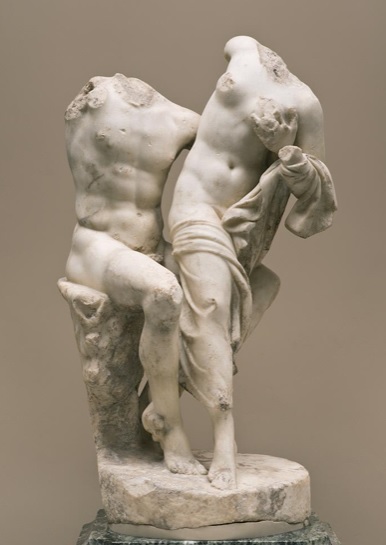
Unknown
Roman
Satyr and Nymph, 2nd c. CE, mid
marble
45 1/2 in.
SBMA, Gift of Wright S. Ludington
1978.4.8
COMMENTS
This statue is made of marble and is Roman from 200 CE. It was probably taken from a Greek original from the Hellenistic period about 200 BCE.
The first character is a satyr. Although the head is missing, the figure can be identified as a satyr by looking at the back of the statue. Satyrs had some very distinct characteristics. In Greek mythology they were part man and part goat. They often had tails, and as can be seen by looking at the small of his back, this one had a tail that is now missing. Satyrs often had beards and horns coming out of their heads like a goat. Unfortunately the head is missing on this one.
Satyrs enjoyed drinking, getting drunk, and chasing Nymphs, of which this one is a beautiful example. Nymphs were lovely creatures who were often found in the presence of gods and they enjoyed frolicking about in the woods. Of course it appears as if this nymph's frolicking days are over. Notice how the artist has skillfully twisted and turned this Nymph demonstrating her outrage and panic at this truly uncomfortable position.She looks as if she could fall over, if the satyr did nothavesuch a tight grasp on her. Also notice how the Satyr is completely naked, while the Nymph, though losing most of her wrap still has part of it clinging around her lovely body .The artist makes the viewer more aware of her nudity by adding this bit of drapery. The nymph with her left hand is trying to remove the Satyrs hand that clutches her breast, while her right hand was probably pulling at his hair. Because his right shoulder is at such an upward angle, he could have been grabbing her other hand to release it from his hair. And notice the legs; they are all at diagonals which represent dramatic action. It would appear that this Nymph has no intention of staying, while the Satyr (notice his foot is even involved in this entrapment) has no intention of letting her go.
Instead of giving the impression that this poor beautiful nymph will succumb to this lecherous satyr, it is appropriate to remember a 16th century play by Garirin. The story is told of a satyr and nymph who were lovers. While the two were in the forest one day, the satyr accused the nymph of being unfaithful to him. As he tries to capture her with one hand on her breast, and the other on her hair, she escapes, leaving her hair behind caught in this hand. She is wearing a wig! Instead of looking at this statue and thinking, of it as another example of male dominance over a woman there may be another possible interpretation.
